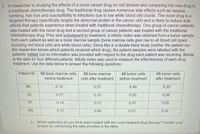
Phlebotomy Essentials
6th Edition
ISBN: 9781451194524
Author: Ruth McCall, Cathee M. Tankersley MT(ASCP)
Publisher: JONES+BARTLETT PUBLISHERS, INC.
expand_more
expand_more
format_list_bulleted
Concept explainers
Question

Transcribed Image Text:2. A researcher is studying the effects of a novel cancer drug on cell division and comparing the new drug to
a traditional chemotherapy drug. The traditional drug causes numerous side effects such as nausea,
vomiting, hair loss and susceptibility to infections due to low white blood cell counts. The novel drug is a
targeted therapy (specifically targets the abnormal protein in the cancer cell) and is likely to reduce side
effects that patients experience when treated with traditional chemotherapy. One group of cancer patients
was treated with the novel drug and a second group of cancer patients was treated with the traditional
chemotherapy drug. Prior and subsequent to treatment, a mitotic index was obtained from a tumor sample
from each patient as well as a bone marrow sample (bone marrow cells give rise to all blood cell types
including red blood cells and white blood cells). Since this is a double-blind study (neither the patient nor
the researcher knows which patients received which drug), the patient samples were labelled with the
patients' initials but no information was provided with respect to the drug each patient was receiving. Below
is the data for four different patients. Mitotic index was used to measure the effectiveness of each drug
treatment. Use the data below to answer the following questions:
Patient ID
MI bone marrow cells
MI bone marrow
MI tumor cells
MI tumor cells
before treatment
cells after treatment
before treatment
after treatment
MJ
0.15
0.07
0.44
0.25
JS
0.17
0.15
0.55
0.08
TF
0.14
0.13
0.47
0.05
KR
0.17
0.04
0.51
0.32
b. Which patient(s) do you think were treated with the novel targeted drug therapy? Explain your
answer by referencing the data provided in the table.
Expert Solution
This question has been solved!
Explore an expertly crafted, step-by-step solution for a thorough understanding of key concepts.
This is a popular solution
Trending nowThis is a popular solution!
Step by stepSolved in 2 steps

Knowledge Booster
Learn more about
Need a deep-dive on the concept behind this application? Look no further. Learn more about this topic, nursing and related others by exploring similar questions and additional content below.Similar questions
- 2. A researcher is studying the effects of a novel cancer drug on cell division and comparing the new drug to a traditional chemotherapy drug. The traditional drug causes numerous side effects such as nausea, vomiting, hair loss and susceptibility to infections due to low white blood cell counts. The novel drug is a targeted therapy (specifically targets the abnormal protein in the cancer cell) and is likely to reduce side effects that patients experience when treated with traditional chemotherapy. One group of cancer patients was treated with the novel drug and a second group of cancer patients was treated with the traditional chemotherapy drug. Prior and subsequent to treatment, a mitotic index was obtained from a tumor sample from each patient as well as a bone marrow sample (bone marrow cells give rise to all blood cell types including red blood cells and white blood cells). Since this is a double-blind study (neither the patient nor the researcher knows which patients received…arrow_forward1. What are tumor antigens? What are tumor proto- oncogenes and tumor suppressors? What are the functions of p53 and BRCA1/2? What are the four types of cancer immunotherapies, and the underlying rationale?arrow_forwardYour friend's oncologist suggests a treatment that causes major DNA damage to both external or internal tumors that are localized. What treatment is she suggesting? • Hormone therapy O Surgery O Radiation therapy O Chemotherapyarrow_forward
arrow_back_ios
arrow_forward_ios
Recommended textbooks for you
 Phlebotomy EssentialsNursingISBN:9781451194524Author:Ruth McCall, Cathee M. Tankersley MT(ASCP)Publisher:JONES+BARTLETT PUBLISHERS, INC.
Phlebotomy EssentialsNursingISBN:9781451194524Author:Ruth McCall, Cathee M. Tankersley MT(ASCP)Publisher:JONES+BARTLETT PUBLISHERS, INC. Gould's Pathophysiology for the Health Profession...NursingISBN:9780323414425Author:Robert J Hubert BSPublisher:Saunders
Gould's Pathophysiology for the Health Profession...NursingISBN:9780323414425Author:Robert J Hubert BSPublisher:Saunders Fundamentals Of NursingNursingISBN:9781496362179Author:Taylor, Carol (carol R.), LYNN, Pamela (pamela Barbara), Bartlett, Jennifer L.Publisher:Wolters Kluwer,
Fundamentals Of NursingNursingISBN:9781496362179Author:Taylor, Carol (carol R.), LYNN, Pamela (pamela Barbara), Bartlett, Jennifer L.Publisher:Wolters Kluwer, Fundamentals of Nursing, 9eNursingISBN:9780323327404Author:Patricia A. Potter RN MSN PhD FAAN, Anne Griffin Perry RN EdD FAAN, Patricia Stockert RN BSN MS PhD, Amy Hall RN BSN MS PhD CNEPublisher:Elsevier Science
Fundamentals of Nursing, 9eNursingISBN:9780323327404Author:Patricia A. Potter RN MSN PhD FAAN, Anne Griffin Perry RN EdD FAAN, Patricia Stockert RN BSN MS PhD, Amy Hall RN BSN MS PhD CNEPublisher:Elsevier Science Study Guide for Gould's Pathophysiology for the H...NursingISBN:9780323414142Author:Hubert BS, Robert J; VanMeter PhD, Karin C.Publisher:Saunders
Study Guide for Gould's Pathophysiology for the H...NursingISBN:9780323414142Author:Hubert BS, Robert J; VanMeter PhD, Karin C.Publisher:Saunders Issues and Ethics in the Helping Professions (Min...NursingISBN:9781337406291Author:Gerald Corey, Marianne Schneider Corey, Cindy CoreyPublisher:Cengage Learning
Issues and Ethics in the Helping Professions (Min...NursingISBN:9781337406291Author:Gerald Corey, Marianne Schneider Corey, Cindy CoreyPublisher:Cengage Learning

Phlebotomy Essentials
Nursing
ISBN:9781451194524
Author:Ruth McCall, Cathee M. Tankersley MT(ASCP)
Publisher:JONES+BARTLETT PUBLISHERS, INC.

Gould's Pathophysiology for the Health Profession...
Nursing
ISBN:9780323414425
Author:Robert J Hubert BS
Publisher:Saunders

Fundamentals Of Nursing
Nursing
ISBN:9781496362179
Author:Taylor, Carol (carol R.), LYNN, Pamela (pamela Barbara), Bartlett, Jennifer L.
Publisher:Wolters Kluwer,

Fundamentals of Nursing, 9e
Nursing
ISBN:9780323327404
Author:Patricia A. Potter RN MSN PhD FAAN, Anne Griffin Perry RN EdD FAAN, Patricia Stockert RN BSN MS PhD, Amy Hall RN BSN MS PhD CNE
Publisher:Elsevier Science

Study Guide for Gould's Pathophysiology for the H...
Nursing
ISBN:9780323414142
Author:Hubert BS, Robert J; VanMeter PhD, Karin C.
Publisher:Saunders

Issues and Ethics in the Helping Professions (Min...
Nursing
ISBN:9781337406291
Author:Gerald Corey, Marianne Schneider Corey, Cindy Corey
Publisher:Cengage Learning